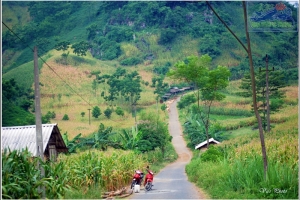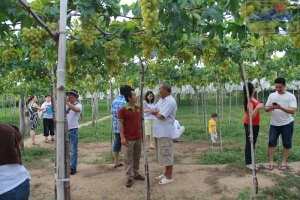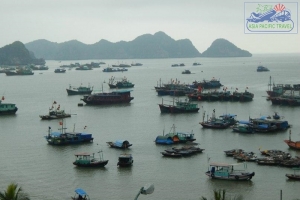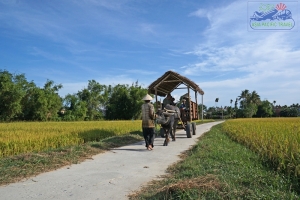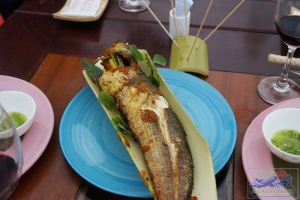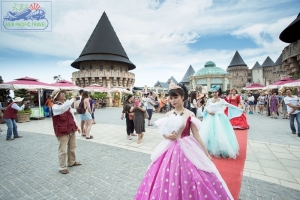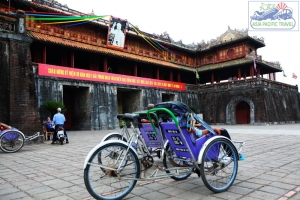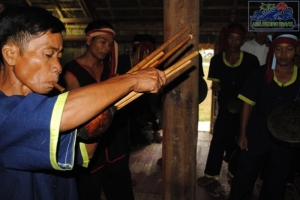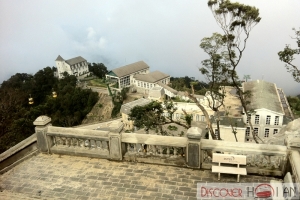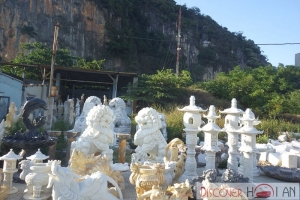
Asia Pacific Travel Team
48 Hours Explore Da Bac - Hoa Binh Province
Located 100km from Ha Noi capital, Da Bac has dramatically become an ideal place for travelers who want to discover the ethnic life of Muong ethnic group, spend a while escaping from the hustling and bustling, and immense in the pure natural landscapes. The road leading to Da Bac is a bit obstacle and tough that may make the arrival moment more delightful.
Coming to Da Bac, visitors can indulge themselves in the fresh atmosphere, experience first- hand the rustic life of local people and enjoy diverse attractive activities like trekking, swimming, hiking, fishing…
Visit Ba Moi's vineyard in Ninh Thuan
Ba Moi’s vineyard has become a popular tourist destination in Ninh Thuan province’s Ninh Phuoc district. The vineyard, famous for producing high-quality grapes through the application of the VietGap cultivation model, has contributed significantly to new rural development in Ninh Thuan.
Hai Phong promotes Cat Ba Island tourism
The northern port city of Hai Phong plans to focus on promoting the tourism potential of the Cat Ba archipelago, which is renowned for its diversity of tourism products.
Quy Nhon launches horse-drawn tours
Authorities in Quy Nhon on the central coast have begun to offer a city sightseeing tour by horse-drawn carriage.
Tourists can choose to go along the beach on Xuan Dieu Street or opt for the city's most beautiful and green street – An Duong Vuong.
Each coach has 12 seats, tickets for which cost VND20,000 (nearly US$1).
Tourists who prefer going around the city by bicycle can hire one at the Central Square on Nguyen Tat Thanh Street for VND30,000 an hour. There are bicycles that one, two, or three people can ride.
VNS
Dong Thap cusine - A real treat of Mekong Delta
Dong Thap Province, around 170 kilometers from HCMC, lies by the Tien River in the Mekong Delta and has various attractive destinations for tourists such as Tram Chim National Park, Gao Giong Eco-Tourism Park, Xeo Quyt Eco-tourism site, Sa Dec flower village, and the ancient house of Huynh Thuy Le, and Kien An Cung Pagoda.
However, the province also offers exotic delicious dishes. Upon arrival at Tram Chim, you should treat yourselves to a lunch inside a canalside bamboo tent surrounded by cajuput forests, fields of green grass Eleocharis, and different species of birds.
That view is best for you to enjoy paddy fried field mice and grilled snakehead fish.
Paddy field mice have been a specialty of the Mekong Delta since the early days of land reclamation. It also reflects the lifestyle of people of the delta: just eat what you have.
The deep fried mice do not only look eye-catching but it is really mouthwatering. The meat tastes soft, sweet and fragrant.
Grilled snakehead fish covered in young lotus leaves is another specialty of Dong Thap, the cradle of lotus in the south.
The fish is grilled in the genuine style of southern farmers. A bamboo stick is pierced through the fish before it is grilled over coal fire and then wrapped in a fresh lotus leaf. The fragrance of the grilled fish mingled with the pleasant smell of the lotus leaf is something tourists to the delta would not forget.
Source: SGT
Summer festival in Ba Na Hills
A collection of summer festivals, titled Colour of Summer, has opened at Ba Na Hills Mountain resort in the Ba Na Mountains, 30km west of the central city of Da Nang. It will run until August 31.
Hue opens tourism day
The 2015 Tourism Day of Thua Thien-Hue province kicked off on July 9 with the aim to promote tourism in the central locality.
Stilt house of Raglai people
The Raglai prefer to build their stilt houses on high land areas near a water resource. Each hamlet has several stilt houses and the villagers are of the same clan.
Traditionally the Raglai perform a ritual to find suitable land on which to build a stilt house. The mistress puts 7 grains of rice on the ground and upturns a bowl on them.
After 3 days and nights, she removes the bowl. If 7 grains remain there, it’s a good place to live. If some grains have disappeared, she will find another place to build.
Stilt houses of the Raglai are made of wood, rattan, bamboo, and leaves. All members of the family are involved in preparing materials and building the house.
Doctor Thanh Phan, a researcher of Raglai culture, said, “Most stilt houses of the Central Highlands groups are imposing. But the stilt houses of the Raglai are smaller and located at the foot of the mountain, surrounded by dense forest. The location of their hamlets and stilt houses has helped them preserve their unique culture.”
A house is built on stilts approximately 1 meter above the ground. The roof is built separately and then set on the house frame. The roof is shaped like an upturned boat, which, experts explain, is a cultural blending of Austronesian groups.
Inside the house, musical instruments are hung on the left wall and spearheads and knives are hung on the right wall. A central pillar supports the roof. The Raglai consider it a spiritual pillar, a way for their ancestors to connect with their descendants during worshiping ceremonies.
There are several wood stoves in a stilt house and the main stove is always lit. Beside the stove, old people tell children the epics, tales, and folksongs of their group.
Raglai people teach the younger generation epics and folksongs anywhere they can, but the most sacred place is next to a wood stove. Listening to old people reciting epics and folksongs, young people can deeply understand the soul of the Raglai culture.
The Raglai have several festivals each year, which are occasions for grandmothers and parents to teach their children morality, etiquette, and culture.
Chamale Nang shared, “I’m proud of my group, which has many stilt houses. At festivals we play Ma La gongs and the Chapi musical instrument. These events help us understand our culture.”
Stilt houses of the Raglai are simply made but strong and durable. In deep forests, the Raglai live in harmony with nature and preserve their time-honored cultural uniqueness.
Source: VOV
Festival "The Colour Of Summer" in Ba Na Hills
A European festival themed “The Colour of Summer” is taking place in Ba Na Hills tourist area in central Da Nang City.
Non Nuoc Village in Da Nang
After a 15-minute ride from the centre of Danang, the biggest city on the Central Coast of Vietnam, I reached its renowned stone carving village, Non Nuoc, which lies at the foot of the picturesque Marble Mountain.


